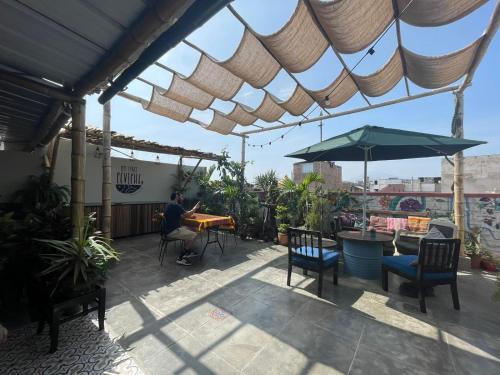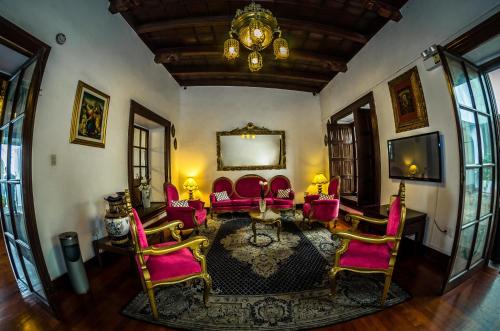Chan Chan, Trujillo, Peru
The enormous ancient mud metropolis of Chan Chan was the largest city in the Americas until Europeans arrived. Now it’s under threat again…
The great Chimu metropolis of Chan Chan in northern Peru has faced two great threats to its existence. One, about 500 years ago. And one right now.
So far, the cultures of Peru I have written about have largely disappeared on their own accord – like the constantly shifting nature they relied on for survival, their civilisations were not built for an eternity.
But now, as I look at a period of the country’s cultural history in the centuries after about 1200AD, we find cultures vanishing by force. And there’s one main cause of it all – the Incas.
The Chimu people once had a vast empire that stretched more than 1000 kilometres from southern Ecuador down the coast of Peru. The people came from the remnants of the Moche – a culture I wrote about earlier in reference to the Huacas del Moche near Trujillo.
And not far from that site is where the great capital of the Chimu, Chan Chan, stood.
Development started in about 850AD and it was the largest city in the Americas before the arrival of Europeans. Made entirely of adobe bricks, Chan Chan covered about 20 km² and was made up of thousands of buildings.
There were grand palaces, public meeting places, and an urban centre that was home to about 30,000 people.
The Chimu people were clever and had invented complex schemes for transporting water to their capital and this, coupled with the bountiful supply of seafood in the ocean, helped them grow and build their strength.
This strength was not enough, though, when the Incas stormed in. The Incas were essentially the Romans of South America.
They built their fabled kingdom by spreading out and taking over other civilisations, imposing their own culture, and redistributing people to different cities so there would never be a concentration of the old.
The Chimu didn’t have a chance against this powerful enemy and their era came to an end in 1470.
The magnificent city of Chan Chan was abandoned and it was only about half a century later that the Spanish arrived and finished the job, looting what was left. (Seeing as much of it was covered in gold and silver worth millions of dollars today, the looting took a while.)
But then it was again abandoned.
Chan Chan was left to fight another enemy – the weather – and it has been fighting it for 500 years now. But now, as the climate changes, the fight has become harder. At present, Chan Chan is under threat and there is a serious concern that climate change could destroy what is left.
You have to remember that this is a city essentially built of mud and rain can just wash it away. When the Chimu occupied it, they were able to immediately fix any damage caused by the weather but there aren’t 30,000 people living there nowadays.
Scientific records show that the amount of the frequency of rain is also much higher now than it has been in the previous centuries, so damage is occurring at a much faster rate.
What is Chan Chan?
Chan Chan was an enormous city that existed on the northern coast of Peru between the 12th and 15th centuries. It was the capital of the Chimu Empire and is considered to be the largest city of the Americas until the Europeans arrived.
What is Chan Chan made of?
One of the most interesting things about the city is what it’s made of. Chan Chan was built with adobe bricks, which are essentially just compressed mud. Usually, another material like small pebbles or straw is mixed in with the mud to give it a bit more strength.
Why is Chan Chan important?
Chan Chan is important in a large part because it was the capital of the large Chimu Empire, which was extremely significant in South America. The architecture and the layout with citadels and palaces was very advanced for the continent. But the style of construction and the art that was carved into the mud makes the site particularly special.
Why is Chan Chan in danger?
Chan Chan was added to UNESCO’s list of World Heritage in Danger in 1986, the same year it was added to the World Heritage List. Because the city was built in mud, it is easily damaged and the site is eroding because of increased rainfall and other changes in the environment because of urban development in the region.
When you visit Chan Chan for yourself, you’ll see some of the damage that’s occurring because of erosion and other environmental effects. But, don’t worry, you’ll still get a very good sense of how incredible this enormous city once was.
Visiting Chan Chan, Trujillo, Peru
This threat from climate change is one of the reasons that visiting Chan Chan is limited to a certain extent. Although it was once an enormous city, there is only one citadel open to the public. You can walk along roads through the city grounds but most of the buildings are now just mounds of dirt.
Some walls stand amongst the dirt, proudly defying the environmental enemies, but they have been abandoned by their brothers who once made a building between them.
But the citadel that’s open, Tschudi, is large and well-restored and gives you an excellent impression of the world the Chimu created. Large mud walls, almost ten metres high, surround the whole complex.
Inside, much like a European castle, are outer courts and inner courts. There is only one entrance and, from there, you can make your way deeper into the more important areas.
Some of the walls have intricate designs of the things that were important to this culture – so lots of seafood. In the middle of the compound, representing the most important thing of all – water – a large lake was used for aesthetic and ceremonial purposes.
Although Chan Chan was a functioning city, the Chimu put great emphasis on art and design and this citadel was one of the ultimate showcases of this.
Where is Chan Chan?
Chan Chan is in northern Peru, about 700 kilometres drive north of Lima. It is about 5 kilometres from the city of Trujillo.
The official address is Av Mansiche, Huanchaco 13011, Peru.
You can see it on a map here.
How do you get to Chan Chan?
There are lots of buses from across Peru to Trujillo. From Trujillo, you can catch the local bus to Huanchaco, which stops at Chan Chan and should cost about S/. 2 (US$0.53). You could also get a taxi or even walk from Trujillo, which is about 5 kilometres away.
When is Chan Chan open?
Chan Chan is open every day from 09:00 – 16:00. But the museum is closed on Mondays.
How much does it cost to visit Chan Chan?
The entrance fee for Chan Chan is S/. 10 (US$2.65) for adults and S/.5 (US$1.35).
You may also prefer to do a guided tour of Chan Chan, so you can have someone explain the different parts of the site. You’ll definitely get a lot more out of the experience if you do that.
There are some great Chan Chan tours that go from Trujillo and also take you to some of the other sites in the region. The best (and cheapest) option is this Chan Chan tour. There are a couple of other ones that are also decent – you could consider this tour or also this tour.
Chan Chan is in danger
Chan Chan was added to the World Heritage List in 1986 and, at the same time, UNESCO named it an at-danger site. The city stood strong for 600 years, it survived an invasion by the greatest military force seen in pre-Columbian South America, and it even got through the pillaging of the Spanish structurally unscathed.
And, after all of that, it managed to maintain much of its form for centuries more of abandonment. Now, unless something is done, climate change might finally mean the end for this great ancient metropolis.
Even if you accept this current period of climate change is caused by humans (as most do), you can’t blame humans entirely for the destruction at Chan Chan. The weather would eventually take its course regardless.
But you have to assume that we, as a species, are somewhat responsible for the threat and it is our responsibility to find a solution… in the case of Chan Chan, sooner rather than later.
Other than Chan Chan, there are quite a few things to see around Trujillo, especially the Huacas del Moche. It may be worth staying a night or two in Trujillo, so here are some accommodation suggestions for you.
THE BEST ACCOMMODATION IN TRUJILLO
The centre of Trujillo has a good selection of places to stay because of the big tourist sights nearby.
BACKPACKER

Along with comfortable beds, there’s a lovely social vibe at Yaqta Hostel, especially on the rooftop terrace.
APARTMENT

The colourful design and the lovely balcony make this apartment a great choice if you want your own space.
BOUTIQUE

A blend of modern and colonial styles, Gran Bolivar Hotel has a good central location and free breakfast.
LUXURY

Large rooms and an outdoor terrace make Hoteles Paraiso one of the nicest options in town, plus it includes a free breakfast.
I love your pictures. They are really inspiring.
Peru is soo interesting, especially when it comes to their culture!
Cool photos and it’s sad news. May the gov take care of Chan Chan.
Enjoy your trip, Sir Turtle!
Very interesting post and pictures! Even though weather threatens it already, I hope preserving better is possible! Thanks for sharing!
This looks a good archaeological place to visit, the images say’s about the beauty of this place…No doubt it is on the list of UNESCO, Even Turkey has it many spots in the list of World Heritage Sites..